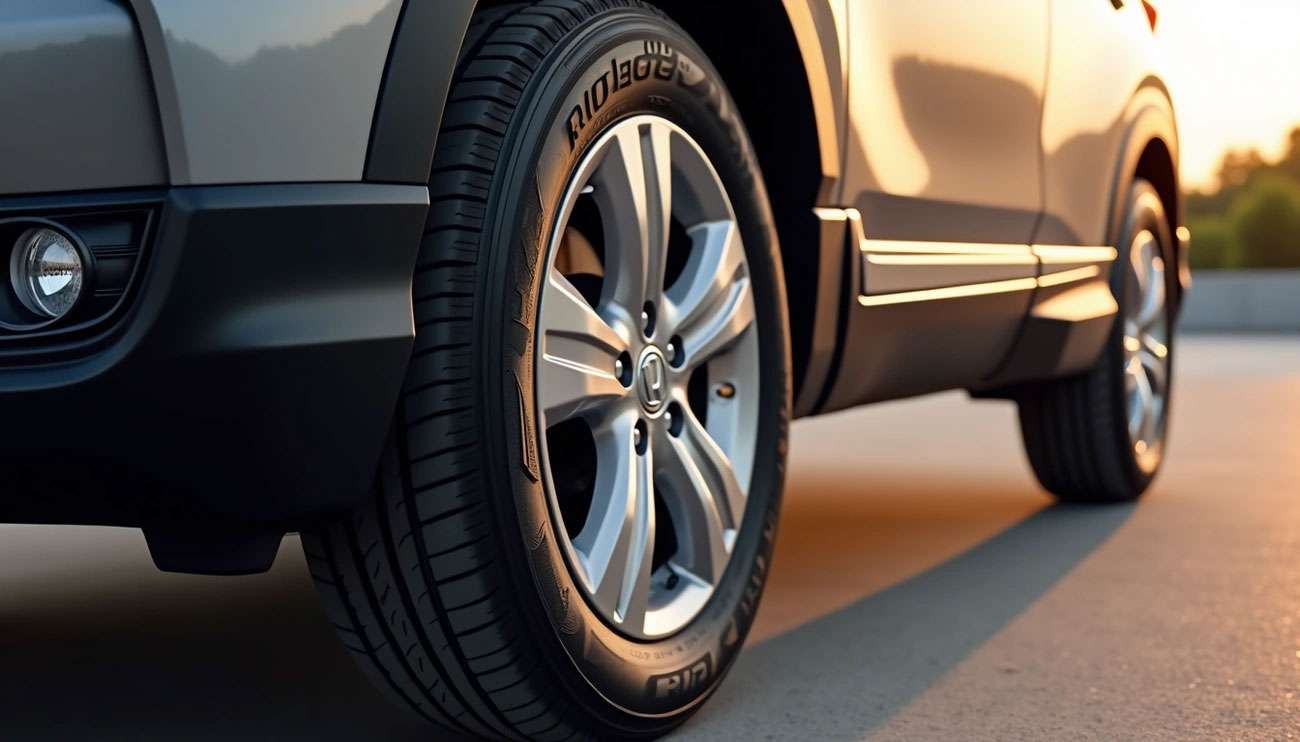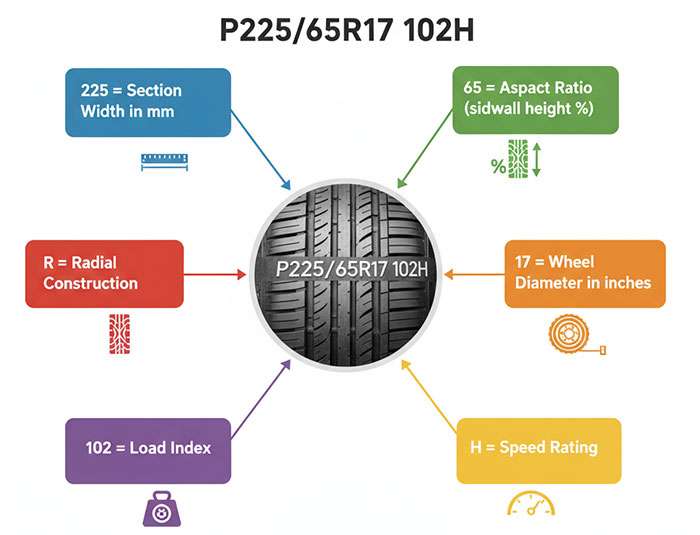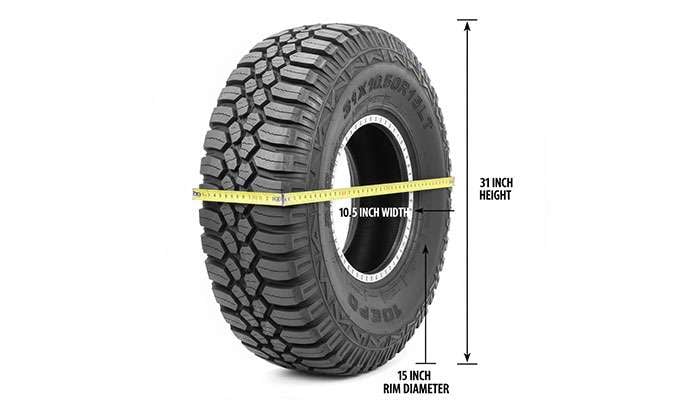
Is 225/65R17 a common tire size? Absolutely. This tire size ranks among the most popular choices for today's mid-size and compact SUVs, crossovers, and light-duty trucks. The 225/65R17 delivers an excellent balance of stability and all-season performance that makes it a go-to option for vehicle manufacturers.
When you look at the 225/65R17 specifications, you'll find a tire with a 28.5" diameter (724 mm), 8.9" tread width (225 mm), and fits perfectly on 17" wheels (431.8 mm). The sidewall measures 5.7" (146 mm) tall, and the tire's circumference spans 89.5" (2273.4 mm). These dimensions create a tire that completes 708 revolutions per mile or 440 revolutions per kilometer.
You'll spot 225/65R17 tires on some of the most popular vehicles on the road today. The Toyota RAV4, Honda CR-V, Subaru Outback, Ford Escape, and Jeep Cherokee all commonly use this size. These tires work with wheel widths between 6-8 inches, giving you flexibility in your wheel selection. What makes 225/65R17 all-season tires particularly attractive is their versatility - they handle everything from daily commuting to weekend adventures.
We'll break down what these tire measurements mean, show you compatible alternatives, and give you all the essential information about this widely-used tire size.
Tire size codes look like random numbers and letters, but they tell you everything about your tire's dimensions and construction. When you understand how to read the 225/65R17 code, you can make smart decisions about tire replacement and vehicle performance.
The 225/65R17 code follows a standard format that gives you precise tire measurements:
225 is the tire's section width in millimeters, measured from sidewall to sidewall. Your tire measures 225mm (or 8.86 inches) wide.
65 shows the aspect ratio - the sidewall height as a percentage of the tire's width. With a 65 aspect ratio, the sidewall height equals 65% of 225mm, which is 146.25mm (or 5.76 inches).
R means radial construction (we'll explain this next).
17 tells you the rim diameter in inches that the tire fits.
Each number affects how your vehicle handles, rides, and performs. When you know what these measurements mean, you can choose the right tires for your driving needs and vehicle requirements.
The "R" in 225/65R17 stands for radial construction, which is now the standard for modern tires. Radial tires have internal plies that run straight across the tire, perpendicular to the direction of travel. This design gives you better fuel efficiency, longer tread life, and improved handling compared to older bias-ply construction.
The aspect ratio (65 in this case) makes a big difference in how your tire performs. A higher aspect ratio means a taller sidewall, which gives you:
Better ride comfort because the sidewall flexes more
Better absorption of road impacts
Improved performance on rough terrain
Lower aspect ratios (like 50 or 55) create shorter sidewalls that provide:
More responsive handling and cornering
Less sidewall flex during turns
A firmer ride quality
Tire experts note that "With any specific aspect ratio, the wider the section width, the taller the sidewall becomes in actual measurement". This relationship between width and height affects everything from ride comfort to how much weight your tire can carry.
The final number in 225/65R17—the 17—shows you the wheel diameter in inches. This measurement must match exactly because tires fit only on their designated rim size. While width offers some flexibility, diameter matching is non-negotiable.
For 225/65R17 tires, the recommended rim width range is 6.0 to 8.0 inches. This range gives you options when selecting wheels, but staying within these limits is essential for proper performance and safety.
Proper fitment matters because wider or taller tires might rub against wheel wells or suspension components, potentially causing tire damage or failure. The rim width-to-tire width ratio also affects how the tire sits on the wheel, which influences handling characteristics.
Getting the fitment right ensures optimal tire performance, safety, and longevity. Mount a tire on the wrong rim size and you risk poor handling, irregular wear, and dangerous blowouts under certain conditions.

Understanding the exact dimensions of your 225/65R17 tires is essential for making informed decisions about vehicle performance, handling, and potential upgrades. These precise measurements in both metric and imperial units tell you everything you need to know about how these tires will perform on your vehicle.
The section width of 225/65R17 tires measures exactly 225 millimeters or approximately 8.86 inches from sidewall to sidewall. While some specifications round this to 8.9 inches, the precise measurement represents the tire's widest point when properly mounted on its recommended rim.
This section width directly impacts three critical performance areas:
Road contact area and traction capabilities
Handling response across different weather conditions
Rolling resistance and fuel economy performance
Most 225/65R17 tires are engineered to mount on rims between 6 and 8 inches wide, ensuring optimal sidewall profile and maximum road contact.
The sidewall height of a 225/65R17 tire measures approximately 146 millimeters or 5.76 inches. This dimension comes from calculating 65% of the section width—that's where the "65" in the tire code originates.
A moderately tall sidewall like this delivers several key advantages:
Superior absorption of road impacts and bumps
Enhanced ride comfort compared to lower-profile alternatives
Excellent balance between comfort and handling responsiveness
The 225/65R17 tire features an overall diameter of approximately 28.52 inches (724 mm), though some sources list it as 28.5 inches. This measurement represents the complete height of the tire from ground contact to the highest point when mounted.
The overall diameter affects three crucial vehicle characteristics:
Proper vehicle clearance and fitment requirements
Accurate speedometer readings and calibration
Maintenance of original gear ratios and performance specifications
The circumference of a 225/65R17 tire measures approximately 89.59 inches. This measurement directly determines how many times the tire rotates for each mile traveled.
A 225/65R17 tire completes between 707-708 revolutions per mile, though some tire models vary slightly due to specific tread designs and construction differences. Other sources cite figures between 730-731 revolutions per mile, highlighting the variations between manufacturers and specific models.
These revolution figures are particularly important for:
Calculating accurate speedometer calibration
Determining fuel economy impacts
Matching performance characteristics between different tire sizes
Keep in mind that as your 225/65R17 tire wears down over its lifespan, the actual diameter gradually decreases, which subsequently affects both circumference and revolutions per mile calculations.

Converting tire sizes from metric to inches helps you understand exactly what your 225/65R17 tires measure in practical terms. The process is straightforward once you know the basic formula.
Every tire conversion starts with one simple ratio: 25.4 millimeters equals 1 inch. To convert any millimeter measurement, divide by this factor.
For the 225/65R17 section width:
Section width = 225 mm ÷ 25.4 = 8.86 inches
Some specifications round this to 8.9 inches for simplicity, but the precise calculation gives you 8.86 inches. This measurement becomes the foundation for all other calculations.
The aspect ratio (65) tells you the sidewall height as a percentage of the section width. Here's how to calculate it:
Sidewall height = Section width × (Aspect ratio ÷ 100)
Sidewall height = 8.86 inches × (65 ÷ 100)
Sidewall height = 8.86 inches × 0.65 = 5.76 inches
You might see this rounded to 5.8 inches in some tire specifications. The aspect ratio directly determines how tall your tire's profile will be.
The final step combines the rim diameter with both sidewall heights:
Tire diameter = Rim diameter + (2 × Sidewall height)
Tire diameter = 17 inches + (2 × 5.76 inches)
Tire diameter = 17 inches + 11.52 inches = 28.52 inches
This matches published specifications showing 28.5 inches overall diameter. Small differences come from rounding variations between manufacturers.
These three calculations work for any tire size, not just 225/65R17. Once you have the diameter, you can determine the tire's circumference (approximately 89.6 inches for this size) and calculate revolutions per mile (around 707 revolutions).
Performance ratings tell you exactly what your 225/65R17 tires can handle. These specifications determine which vehicles can safely use these tires and the conditions where they perform best.
Speed ratings show the maximum speed your tire can safely maintain when properly inflated. Most 225/65R17 tires feature one of three common ratings:
T-rating: Safe up to 118 mph (190 km/h), perfect for family sedans and vans
H-rating: Safe up to 130 mph (210 km/h), the most popular choice for sport sedans and daily drivers
V-rating: Safe up to 149 mph (240 km/h), designed for performance vehicles
H-rated tires deliver balanced performance with excellent longevity. V-rated options provide superior handling through softer compounds but typically wear faster. The speed rating appears as the final letter in the tire code - in P225/65R17 102H, the H shows the speed rating.
The load index tells you the maximum weight each tire supports when properly inflated:
Load index 102: Handles up to 1,874 lbs (850 kg) per tire
Load index 106: Supports up to 2,094 lbs (950 kg) per tire
These numbers connect directly to tire construction:
Standard Load (SL): Features load index 102 with 36 psi maximum inflation pressure
Extra Load (XL): Uses load index 106 with reinforced internal structure and 42 psi maximum inflation
XL tires provide enhanced durability through reinforced shoulders. They're ideal for heavier vehicles or those frequently carrying loads.
Proper inflation keeps your tires performing at their best. For 225/65R17 tires:
SL tires: Recommended pressure range 26-36 psi
XL tires: Recommended pressure range 26-42 psi
At 35 psi, SL tires carry 1,821 lbs. At 42 psi, XL tires reach their full 2,094 lbs capacity.
Ford vehicles with 225/65R17 tires typically recommend 35 psi front and 30 psi rear for normal loads, increasing to 35 psi front and 44 psi rear when fully loaded.
Finding the right replacement for your 225/65R17 tires means understanding which alternatives work safely with your vehicle. Several compatible options exist that maintain proper performance while giving you flexibility for different driving needs.
You have several solid replacement options for 225/65R17 tires, including 215/65R17, 235/65R17, 225/60R17, and 235/60R17. Many drivers also choose 235/55R17 or 225/55R18 as alternatives. Each option changes your vehicle's handling, clearance, and speedometer accuracy in different ways.
Before switching to any alternative size, check your vehicle manufacturer's recommendations and make sure you have adequate wheel well clearance. These compatible sizes work well on popular crossovers like the Toyota RAV4, Honda CR-V, and Subaru Outback.
The 235/65R17 gives you 10mm more width than the 225/65R17. This translates to a section width increase of 0.39 inches (4.3%). The overall diameter grows by 0.51 inches (1.8%) to reach 29.03 inches.
You'll get a sidewall height of 6.01 inches with 235/65R17 compared to 5.76 inches for 225/65R17 - that's a 0.26-inch (4.3%) increase. This size change stays within safe parameters while providing better traction from the wider contact patch.
Get Discount 225/65R17 Tires from Performance Plus Tire that match your vehicle's specifications perfectly.
Switching from 225/65R17 to 225/60R17 keeps the same width but drops sidewall height from 5.76 to 5.31 inches (7.7% decrease). The overall diameter shrinks by 0.89 inches (3.1%) to 27.63 inches.
This change affects your speedometer - when it shows 65 mph, you'll actually be traveling around 62.98 mph. The revolutions per mile jump from 707.26 to 729.94 (3.2% increase). The shorter sidewall gives you sharper cornering response but may create a firmer ride.
Tire experts use the 3% rule as the safe limit for diameter changes. Going beyond this can hurt vehicle handling, interfere with safety systems, and potentially void your warranty.
For most vehicles, the 3% threshold equals about 0.75 inches in overall diameter. Both 235/65R17 and 225/60R17 options stay within this guideline (1.8% increase and 3.1% decrease respectively).
Use a tire size calculator when selecting replacements to verify diameter differences stay within the 3% range, keeping your speedometer accurate and vehicle dynamics intact.
The 225/65R17 tire size has earned its place as one of the most trusted choices for SUVs, crossovers, and light trucks across the automotive landscape. From the Toyota RAV4 to the Honda CR-V and Subaru Outback, this size delivers consistent performance that vehicle manufacturers rely on.
The numbers tell the story - 225mm width, 65% aspect ratio, and 17-inch rim compatibility create a 28.5-inch diameter tire that strikes the perfect balance. This combination provides the stability you need for highway driving and the comfort your passengers expect on longer trips.
Speed ratings and load indexes matter when you're selecting your next set of tires. Whether you need T-rated performance for daily family use or prefer H-rated capabilities for more spirited driving, matching these specifications to your actual needs ensures you get the performance you're paying for.
Replacement options give you flexibility when the time comes. The 235/65R17 and 225/60R17 alternatives both work well, provided you stay within that critical 3% diameter rule that keeps your vehicle's systems functioning properly. For quality replacements that meet your vehicle's exact specifications, getting discount 225/65R17 tires from Performance Plus Tire gives you the reliability and value you're looking for.
This tire size handles the variety of driving conditions modern drivers face. Daily commutes, weekend trips, and occasional light off-road adventures all fall within its capabilities. With the knowledge you now have about dimensions, compatibility, and performance ratings, you can make tire decisions that deliver safety, performance, and value for years ahead.
Understanding the 225/65R17 tire size helps you make informed decisions about replacement, compatibility, and vehicle performance for your SUV or crossover.
225/65R17 is extremely common - Found on popular vehicles like Toyota RAV4, Honda CR-V, and Subaru Outback with 28.5" diameter and 8.9" width
Tire code breakdown matters - 225mm width, 65% aspect ratio, radial construction, 17" rim diameter determine performance and fitment
Load ratings affect capacity - Standard Load (102) supports 1,874 lbs while Extra Load (106) handles 2,094 lbs per tire
Compatible alternatives exist - 235/65R17 and 225/60R17 work as replacements when staying within the 3% diameter rule
Proper pressure is critical - Maintain 26-36 PSI for standard load or 26-42 PSI for extra load tires for optimal performance
This versatile tire size strikes the perfect balance between comfort and handling, making it ideal for daily driving while providing the durability needed for light off-road adventures.
The most common speed ratings for 225/65R17 tires are T (up to 118 mph), H (up to 130 mph), and V (up to 149 mph). H-rated tires offer a good balance of performance and longevity, while V-rated tires provide superior handling but may wear faster.
Standard Load (SL) 225/65R17 tires typically have a load index of 102, supporting up to 1,874 lbs per tire. Extra Load (XL) versions usually have a load index of 106, supporting up to 2,094 lbs per tire. XL tires have reinforced internal structures for enhanced durability.
The recommended tire pressure range for 225/65R17 tires is generally 26-42 PSI. Standard Load tires typically range from 26-36 PSI, while Extra Load tires can go up to 42 PSI. Always refer to your vehicle's specifications for the optimal pressure.
Yes, some compatible alternatives to 225/65R17 tires include 215/65R17, 235/65R17, 225/60R17, and 235/60R17. However, it's crucial to stay within the 3% diameter rule and check your vehicle's manufacturer guidelines before making any substitutions.
225/65R17 tires are commonly found on popular mid-size SUVs, crossovers, and light trucks. Some examples include the Toyota RAV4, Honda CR-V, Subaru Outback, Ford Escape, and Jeep Cherokee. This size offers a good balance of stability, handling, and comfort for everyday driving.